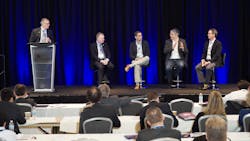Scaling quantum information systems: Photonics holds the keys
MODERATOR:
JOHN DEXHEIMER, President, LightWave Advisors
PANELISTS:
TIM DAY, Ph.D., Executive Chairman, ColdQuanta
CHRIS MONROE, Ph.D., CEO, IonQ
JAMIL ABO-SHAEER, Ph.D., CEO, Vector Atomic
GRAEME MALCOLM, Ph.D., CEO, M Squared Lasers
The commercialization of quantum technology is a much-discussed topic and panel moderator John Dexheimer took the current level of interest as his headline: “Quantum information has entered a land rush of global investments.” Governments in China, Europe, and North America are devoting multi-billion-dollar programs to quantum technologies, and commercial investment is flowing as well. Leading venture and private equity funds as well as major corporations compete for rapid investments of considerable size.
Why? Dexheimer cited the Boston Consulting Group’s 2018 report that estimates a quantum computing market of nearing $60 billion in 2035, which would grow further to $295 billion in 2050. So, there are plenty of opportunities for photonics companies to innovate and expand in this field. Therefore, Dexheimer presented his panelists with three major questions (see Fig. 1):
1. What do systems vendors need from the photonics sector in terms of component specs/technologies?
2. Are we at the stage where it is “just engineering,” or is there still science to do?
3. Where do you see the applications in terms of volumes in three and seven years?
The first presenter, Tim Day from ColdQuanta, gave more details on recent investments and the plentiful potential applications and markets. With a short case study on quantum computer photonic subsystems, he also addressed the first of Dexheimer’s questions.
Second panelist Chris Monroe was introduced as the de-facto speaker of the U.S. National Quantum Initiative and founder of IonQ, where he brought in investment from Google Ventures and Amazon. But he is also a hardware guy: He gave a short introduction of basic building blocks needed for quantum computing, such as miniature vacuum packages to store atoms, or lasers that are stable to nine or 10 digits of accuracy. For scaling up quantum technology, he sees a strong need for an engineering phase. That is one reason to start a company in which physicists, engineers, and software staff work together on quantum technology.
The third panelist was Jamil Abo-Shaeer from Vector Atomic. This one-year-old startup focuses on commercializing quantum technologies for navigation, telecommunications, and oil and mineral exploration. His role was to give an overview of opportunities and requirements for quantum sensors. These sensors are not only the most precise measurement devices on the planet, they also have the shortest time horizon to market. The technology for atomic clocks exists, and can be used to build inertial sensors, magnetometers, and field sensors that are all best-in-class.
But, as Shaeer said, “What industry needs to focus on is integration, operability in real-world environments, and reliability.” And the photonics industry has to reduce prices for lasers if they want to compete with established sensor technology. The same holds for electronics.
The last panelist was Graeme Malcolm from M Squared Lasers, a 100-person photonic and quantum technologies company. Citing Bill Gates, he noted the limits of current technology: If the sheer volume of mankind’s data grows steadily, we will run out of appropriate computing capacity.
Quantum computing may help, but that’s challenging. For example, M Squared built a laser with extreme phase stability for qubits with 99.99% fidelity. Still, more qubits are needed and so are more laser systems (see Fig. 2). Based on market research from Tractica, Malcolm expects the market for lasers in quantum systems to go beyond $1 billion within the next five years.Not unexpectedly, this panel commanded a lot of attention and discussion from a full audience, which is quite unusual for the last event of the day. The discussion went from expectations of laser features to the need for new thinking about quantum computing. It won’t be perfect for all problems, but it may open up entirely different solutions. One important point was made before the cocktail hour: Further standardization of laser technology will be a key issue for the development of very small, inexpensive lasers for quantum computing.
DOWNLOAD FULL REPORT >>>

Andreas Thoss | Contributing Editor, Germany
Andreas Thoss is the Managing Director of THOSS Media (Berlin) and has many years of experience in photonics-related research, publishing, marketing, and public relations. He worked with John Wiley & Sons until 2010, when he founded THOSS Media. In 2012, he founded the scientific journal Advanced Optical Technologies. His university research focused on ultrashort and ultra-intense laser pulses, and he holds several patents.

